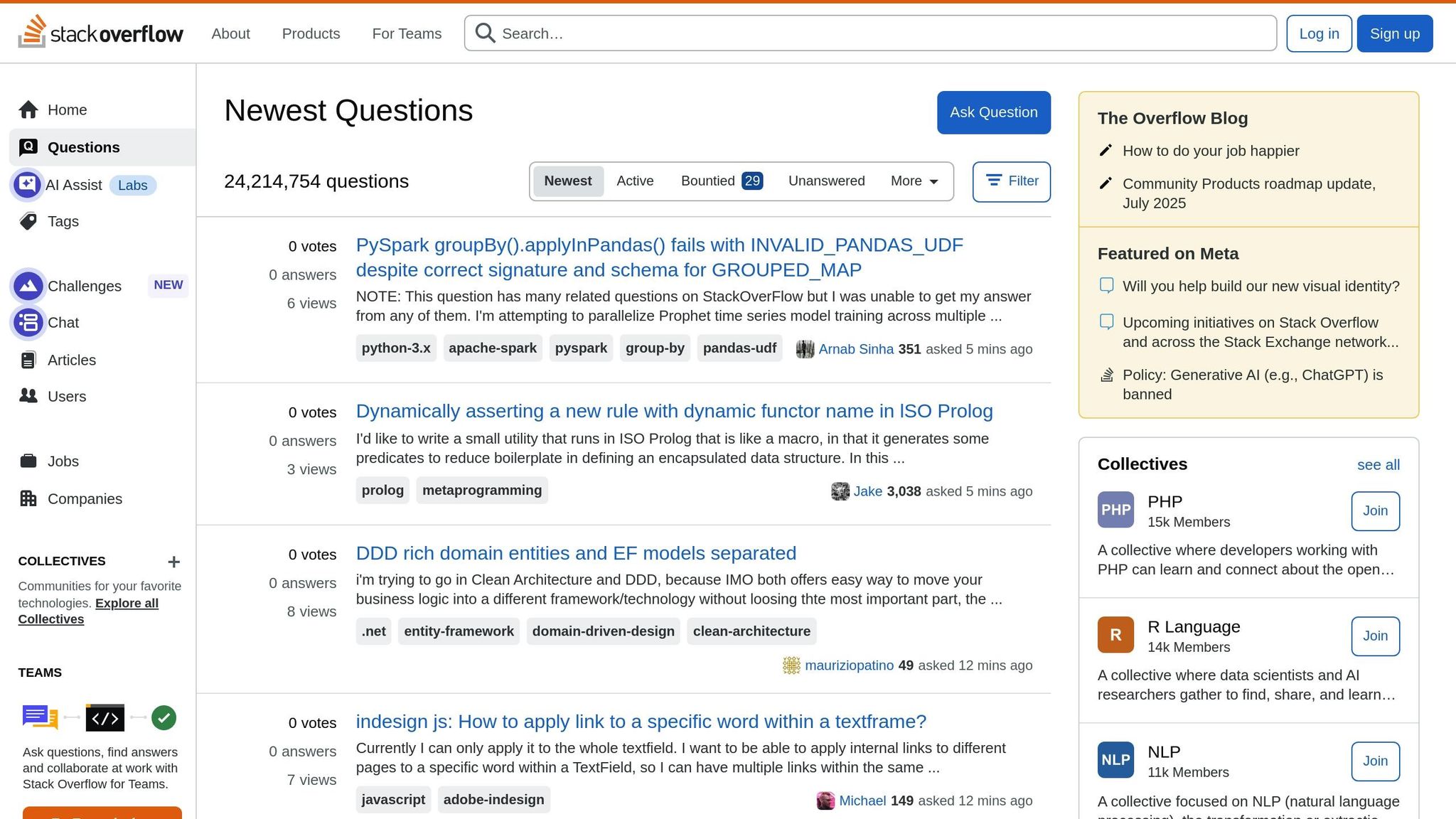


Learn how to effectively present developer marketing results to CMOs by connecting technical metrics to business outcomes while preserving developer context.
When presenting developer marketing results to your CMO, the goal is to link technical metrics to business outcomes without losing the developer context. CMOs focus on revenue, ROI, and customer acquisition costs, while developers value metrics like API adoption and community engagement. The challenge is bridging these perspectives effectively.
Here’s how to do it:
- Start with business metrics: Highlight ROI, lead conversion rates, and customer lifetime value to align with executive priorities.
- Translate technical metrics: Connect developer-focused data (e.g., GitHub stars, API downloads) to revenue-driving activities like customer acquisition or retention.
- Use clear visuals and summaries: Present data in a structured, concise way that’s easy for executives to digest.
- Incorporate developer feedback: Share qualitative insights to show how technical changes impact business performance.
- Frame technical wins as business drivers: For example, explain how improved API adoption shortens sales cycles or boosts customer satisfaction.
What CMOs Want to See
Business Metrics CMOs Track
CMOs zero in on numbers that directly affect the bottom line. When they evaluate developer marketing reports, they’re primarily looking for financial data that proves every marketing dollar is pulling its weight.
At the top of their list are revenue and ROI metrics. They want clear evidence linking marketing spend to revenue growth. Metrics like return on investment (ROI) and return on ad spend (ROAS) are non-negotiable.
Another key focus is customer acquisition costs (CAC) paired with lifetime value (LTV). CMOs need to know how much it costs to bring in a developer customer and what that customer is worth over time. These insights help justify marketing budgets and guide spending decisions.
Lastly, lead generation and conversion rates are essential. For example, Adobe saw a 23% boost in ROI and managed to reallocate $5 million to more effective channels by tracking six or more metrics.
This emphasis on financial outcomes highlights a recurring challenge: aligning developer-specific data with broader business goals.
Why Developer Metrics Don't Connect
Even though business metrics are clear, technical indicators often feel disconnected from executive priorities. Developers tend to value metrics like API adoption rates, SDK downloads, and GitHub stars - but these don’t directly translate to revenue. Instead, they measure engagement, which is harder to tie to financial outcomes.
Metrics like community engagement - such as activity on developer forums, mentions on Stack Overflow, or contributions to open-source projects - can reflect brand health. However, CMOs often struggle to link these to traditional business metrics.
The numbers paint a stark picture: only 28% of CMOs can confidently connect marketing efforts to revenue, while 79% of CEOs believe marketing focuses too much on vanity metrics. Developer-focused campaigns often measure success through technical adoption rather than immediate sales, widening the disconnect.
Compounding the issue, developer marketing often relies on long-term indicators like satisfaction scores, API retention rates, and community growth. These metrics unfold over time, while CMOs are pressured to deliver results on a quarterly basis. The mismatch between developer engagement timelines and business cycles creates additional friction.
Why Translation Matters
Bridging the gap between technical metrics and business results is critical - not just to tell the developer story, but to meet the expectations of CMOs. When technical metrics don’t align with business objectives, developer marketing programs risk being deprioritized during budget reviews.
Translating developer engagement into revenue-focused metrics can protect budgets and elevate developer marketing from a “nice-to-have” to a strategic priority. This is especially important when 48% of CFOs consider marketing the first area to cut during budget constraints.
"Marketing must be seen as a strategic investment, not just a cost, with customer focus driving boardroom influence." - George Berry, Global Executive Search, MSc Organizational Psychology, Coach
The growing divide between executives and marketing leaders underscores this urgency. Between 2023 and 2025, the measurement gap widened by 20%, with 70% of CEOs prioritizing revenue and margin-focused metrics, compared to just 35% of CMOs. Closing this gap requires deliberate efforts to link technical achievements to business goals.
When CMOs translate technical wins into business language, they not only build credibility but also position themselves as strategic leaders. This approach protects developer marketing programs and can even secure greater investment, ensuring these initiatives remain an integral part of the business strategy.
Connecting Developer Metrics to Business Results
Linking Developer Engagement to Business Value
To tie developer metrics to business outcomes, start by identifying a "keystone metric" that carries a clear monetary value. This could be something your company already tracks, like sign-ups, monthly active users (MAU), average deal size, or app downloads. Using existing revenue data and conversion rates, assign a dollar value to this keystone metric.
The Keystone DevRel Metrics framework breaks developer engagement into four main categories: Reach, Awareness, Engagement, and DevRel Qualified Leads. Each category has a different financial impact. For instance, "Reach" is often valued at $0.50–$1.00 per unit due to its high volume but lower traceability, while a single DevRel Qualified Lead can result in hundreds or even thousands of registrations.
Key engagement indicators include tracking registrations, active participation in webinars, and downloads of developer-created libraries. Additionally, high developer satisfaction has been shown to boost productivity by 28% and reduce turnover by 30%, leading to better efficiency and lower hiring costs. These metrics lay the groundwork for measurable business impact, illustrated through real-world examples.
Using Examples to Show Business Impact
Real-world examples help demonstrate how developer metrics translate into business results, making the case clearer for executives. For example, Northmill improved customer conversion rates by 30% by overhauling its KPI management, optimizing data processes, and enabling easier access to key insights across teams. Similarly, Austin Capital Bank used data analytics to cut paid-search expenses by 50% while increasing revenue margins by 30%.
These examples highlight how technical changes can directly influence financial outcomes. To connect awareness metrics to the keystone framework, consider conversion paths. For instance, if one registration occurs per ten content interactions, then 10,000 documentation views could generate approximately 1,000 sign-ups.
Mixing Technical Data with Executive Summaries
To make reports resonate with both technical teams and executives, adjust the language and structure of your presentation. Guillermo Manzo from Expedia Group offers this advice:
"For non-technical executives, you may use language like 'time to market' rather than 'Cycle Time.' Making sure that depending on who you're talking to, your metrics may look a bit different, based on what is most important to the person receiving this information".
Organize your reports by starting with an executive summary that highlights the business impact - addressing questions about ROI, customer acquisition, and revenue potential. Follow this with detailed technical data for teams needing in-depth insights. Reframe technical improvements as investments, emphasizing how they drive returns by enabling revenue-generating activities rather than just "saving hours".
Using an investment profile approach is another way to show the value of developer marketing efforts. As Yishai Beeri from LinearB explains:
"An investment profile is a good bridge area between product and engineering because it represents where we are actually investing. Not the plan, the actual work - where is it actually happening?".
Finally, engagement metrics provide a clear view of how users interact with your content, products, or services. Presenting these metrics alongside their business implications reinforces the connection between developer efforts and tangible business outcomes. This approach ensures the developer story remains relevant and impactful.
Building Clear and Effective Reports
Key Parts of a Developer Advertising Report
A well-crafted developer advertising report highlights the achievements of your team while directly tying them to business outcomes. It should clearly showcase how campaigns drive engagement and revenue, connecting metrics like MQLs (Marketing Qualified Leads) and SQLs (Sales Qualified Leads) to tangible results.
Begin by reminding your CMO of the broader goals and include data that demonstrates how developer engagement contributes to the sales pipeline. The report should justify marketing expenses, optimize how resources are used, and pinpoint what’s driving revenue. As Hans Rosling once said:
"The most important thing you can do to avoid misjudging something's importance is to avoid lonely numbers. Never, ever leave a number all by itself. Never believe that one number on its own can be meaningful. If you are offered one number, always ask for at least one more. Something to compare it with."
To ensure clarity, avoid technical jargon, irrelevant metrics, or visuals that lack context. Instead, focus on presenting actionable insights that resonate with both technical teams and executives. Providing clear next steps and maintaining a clean, straightforward layout will enhance the report’s impact.
Formatting Reports for US Standards
When presenting data to US-based CMOs, consistency in formatting is key to building trust and avoiding confusion. Use the USD symbol ($) with proper comma separators for large numbers - for example, show revenue as $2,300,000 instead of 2.3M or using European conventions. Dates should follow the MM/DD/YYYY format (e.g., 03/15/2024 – 04/15/2024), and time-sensitive metrics should use the 12-hour clock with AM/PM. Additionally, ensure fractional numbers use decimal points, and large figures include commas for easier readability (e.g., 12.5% conversion rates or user counts of 45,000). Attention to these details not only enhances professionalism but also ensures the data is immediately understandable to a US audience. Once formatting is standardized, the next step is choosing tools that make your data visually compelling.
Tools for Better Data Presentation
The right data visualization tools can transform raw metrics into polished, impactful presentations for executives. Research shows that companies using visual data discovery tools are 28% more likely to uncover timely insights compared to those relying on traditional query-based methods.
For instance, Microsoft Power BI is a great option for organizations already using Microsoft products. Power BI Pro costs $14 per user per month, while Power BI Premium Per User is priced at $24 per user per month. On the other hand, Tableau is renowned for its interactive dashboards and advanced analytics capabilities. The Tableau Creator plan is available for $70 per user per month. As one expert puts it:
"Tableau has been a premier tool for data visualization since its founding in 2003, beginning as a computer science project at Stanford University. It excels in enabling users to create interactive and shareable dashboards, which highlight trends, variations, and density of data in the form of graphs and charts."
If you’re working with a smaller team or a limited budget, Google Data Studio (Looker Studio) is a free and user-friendly option. Similarly, Zoho Analytics offers affordable plans starting at $25 per month for two users.
When selecting a tool, consider factors like your organization’s specific needs, the technical expertise of your team, real-time update capabilities, customization options, and budget. With over 70% of businesses expected to adopt data visualization tools by 2025, leveraging these tools can elevate your marketing dashboards and strategic decision-making. Clear and engaging visualizations ensure that your technical achievements are effectively woven into the larger business story.
Breaking Down B2D Marketing with the Chief Marketing Officer of Stack Overflow

sbb-itb-e54ba74
Keeping the Developer Story in Executive Reports
When crafting executive reports, it’s not just about presenting numbers - it’s about preserving the story behind them. Stripping away technical details can often erase the narrative that informs future strategies. The goal is to strike a balance: keeping the technical authenticity intact while ensuring the data resonates with an executive audience.
Adding Developer Feedback and Insights
Numbers alone don’t tell the full story. Including developer feedback and qualitative insights can highlight how specific changes have made a real-world impact. For instance, instead of simply reporting a rise in metrics, share how an updated documentation process helped streamline integrations and speed up project completion times. These types of insights connect technical efforts to tangible outcomes.
To make this process effective, establish a structured feedback system, such as bi-weekly surveys, to gather insights that bridge the gap between technical teams and executives. Focus on targeted questions that directly tie to business outcomes. Interestingly, using anonymous feedback channels can increase participation rates by 40%. Additionally, rotating feedback responsibilities among team members has been shown to boost collaboration scores significantly, from 60% to 82% over six months.
By linking developer feedback to measurable outcomes, you can position these insights as strategic tools that drive business performance.
Positioning Technical Wins as Business Drivers
Technical achievements gain greater significance when framed in terms of their impact on the organization. Emmanuel Makokha, Career Growth Coach, puts it best:
"Executive positioning is how the right people experience your value before you even walk into the room".
Instead of focusing on activities, emphasize the results. For example, rather than reporting a rise in documentation engagement, explain how the improved strategy reduced onboarding time, sped up time-to-value, and boosted customer satisfaction. Similarly, when discussing increased community metrics, highlight how this growth signals stronger developer validation and sets the stage for organic product adoption.
Key business drivers, such as improved API adoption or heightened community engagement, can be directly tied to outcomes like shorter sales cycles and expanded market opportunities. Framing technical wins this way demonstrates their strategic value and positions them as essential to the organization’s success.
Using Stories to Connect Data to Results
Data becomes more impactful when paired with a compelling story. The best executive reports weave technical achievements into narratives that illustrate clear business progress. Start by identifying the business challenge, introduce the technical solution, and conclude with the measurable impact. For example, if enterprise clients were experiencing integration delays, highlight how targeted developer education campaigns addressed common issues, leading to faster integrations, improved customer satisfaction, and fewer support requests.
Teams that hold weekly feedback sessions often see performance improvements of 10–20%. Using frameworks like the Situation-Behavior-Impact model can help link technical efforts to concrete business results. By focusing on outcomes rather than activities, you can position technical wins as key drivers of organizational success.
The most effective reports seamlessly blend hard data with qualitative insights. This approach satisfies both the executive need for high-level metrics and the development team’s desire for technical acknowledgment, all while keeping the developer narrative front and center.
Conclusion: Reports That Work for Developers and CMOs
Reports need to strike a balance between the technical depth developers value and the business outcomes CMOs prioritize. The best developer marketers understand that connecting technical metrics to business KPIs creates a space where authenticity and executive goals can align seamlessly[44,47].
For instance, tying API adoption rates to customer acquisition or linking community engagement with revenue growth highlights the developer story while demonstrating measurable business impact. CMOs, in turn, need to showcase how marketing efforts directly contribute to these outcomes. This dual focus ensures reports resonate with both technical and executive audiences.
Using standard US formatting helps remove any confusion, while visual dashboards and concise executive summaries make complex data easier to digest, offering clear, actionable insights.
Maintaining the developer narrative is key to preserving the unique value that drives innovation and long-term success. Incorporating developer feedback alongside performance metrics and spotlighting technical achievements as business wins demonstrates that developer marketing is a strategic priority. This approach strengthens its role as a critical driver of growth.
Ultimately, organizations that excel in this area focus on meaningful performance metrics and consistently refine their reporting processes to reflect evolving business objectives and industry shifts[44,47]. In today’s data-driven marketing landscape, crafting a unified story backed by strong metrics isn’t optional - it’s indispensable.
When reports effectively address both developer and CMO perspectives, they become more than just documents - they become powerful tools for smarter decision-making and better business outcomes.
FAQs
How can I present developer metrics in a way that highlights business value for my CMO?
To bridge the gap between developer metrics and business outcomes, it's critical to align technical data with key business KPIs such as revenue growth, customer retention, or operational efficiency. Show how developer engagement contributes to these outcomes by using clear, relatable examples and straightforward explanations.
Incorporate visual aids like charts or graphs to break down complex data and highlight trends effectively. Focus on the broader business impact while staying true to the developer narrative. This approach helps your CMO grasp the strategic value of your work without overlooking the technical aspects.
What are some key metrics that connect technical performance with business outcomes?
Key Metrics Connecting Technical Performance to Business Outcomes
Some metrics can directly tie technical performance to measurable business results. For instance, defect rates offer a clear picture of product quality, while customer satisfaction scores reveal how users feel about their experience. On the financial side, revenue growth linked to technical upgrades demonstrates the tangible benefits of innovation.
Other valuable indicators include the net promoter score (NPS), which measures customer loyalty and their likelihood to recommend your product or service. Additionally, tracking the business impact of tech integrations can show how technical initiatives align with and drive broader strategic objectives. These metrics are essential for translating developer-centric data into actionable insights that resonate with CMOs and other decision-makers.
Why should developer feedback be included in reports to CMOs, and how does it influence business decisions?
Including developer feedback in reports to CMOs is crucial because it offers key insights into technical challenges, user behavior, and how the product is performing. This kind of input sheds light on areas that need attention and helps connect developer-focused metrics to the company’s broader business objectives.
By weaving in this perspective, your reports maintain their technical credibility while giving CMOs the context they need to make smarter, more strategic decisions. It creates a connection between developer engagement data and executive priorities, building trust and paving the way for meaningful results that benefit the business.






